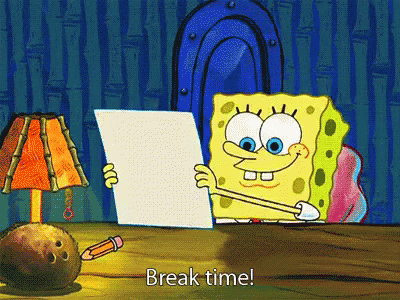HI, KIDS
Welcome to a new online lesson!
Before getting ready to start studying, I've got some news for you... - Antes de prepararnos para empezar a estudiar, tengo noticias para ustedes...
8th May - 1st test/8 de Mayo - 1er prueba
Los temas incluyen unidad 10, unidad 11 y lo aprendido hasta esta clase inclusive. Las próximas dos clases serán de repaso.
.
.
.
.
.
.
.
Ready to start?
Ok, we're going to start with a new topic:
The Present Continuous
El Presente Continuo es un tiempo de verbo que usamos para describir una acción que está pasando ahora y es temporal. Example:
- I am studying now. - Yo estoy estudiando ahora.
- She's eating cake. - Ella está comiendo torta.
- David and Belen are working. - David y Belen están trabajando.
---👆 ACTIONS HAPPENING NOW 👆---
Ahora que leyeron las oraciones, hay 2 cositas que todas ellas tienen en común. Léanlas de nuevo y tómense 5 minutos para pensar.
.
.
.
.
.
.
.
.
.
.
Todas las oraciones tienen el To Be (am, is, are) y el verbo principal con -ing.
I am studying now.
She's eating cake.
David and Belen are working.
Acordate que siempre, pero siempre, cuando vayamos a describir algo que está pasando AHORA, no nos puede faltar el To be y el -ing.
Cuando nosotros estudiamos un tiempo de verbo como este, tenemos que aprender a aplicarlo de distintos modos para hablar de forma natural.
"¿Cómo es esto, Miss?"
Estos ejemplos están afirmando (Affirmative form). Es decir, estamos diciendo algo como si fuera cierto. -I am working now.-
Sin embargo, hay 2 modos más; Negative & Interrogative.
Y si en el Modo Afirmativo, afirmamos... ¿qué hacemos en el Modo Negativo? Pos claro, negamos.
¿Y en el Modo Interrogativo? Pos claro, preguntamos.
Estudiemos los siguientes ejemplos.
Negative form
- Gary isn't cooking.
- I'm not sleeping.
- Mark and Peter aren't eating hot dogs.
¿Cómo negamos? Agregando "not" al To be;
am not - isn't - aren't
Fíjense que no importa el modo, tanto el To be como el -ing están siempre presentes.
.
.
.
Let's practise
Put the following sentences in the Negative form (send me your answers via Whatsapp)
1. Julio is reading a book now. --> Julio isn't reading a book now.
2. Jere is playing football. -->
3. Guada is singing. -->
4. Augus and Bauti are making a snowman. -->
5. I'm travelling by train. -->
----------------------------------------
Interrogative form
- Are you wearing a hat?
- Is your mom listening to music?
- Are Gena and Valen making a cake?
- Is Santi playing outside?
¿Qué hicimos acá? Simple, pasamos el To be al principio de nuestra oración. De este modo hacemos una pregunta en el Presente Continuo.
El orden es el siguiente:
To be + subjet (persona que realiza la acción) + verb -ing
Are you watching a video now?
Let's practise. Again, send me your answers.
Order the words.
1. Lauti / running / ? / Is --> Is Lauti running?
2. Lili and Jake / ? / working / Are -->
3. ? / you / chocolate / Are / eating -->
4. I / dinner / ? / Am / having / now -->
5. visiting / Is / ? / Bobby / his grandma -->
--------------------------------------
Take a break
.
.
.
.
.
.
.
.
.
.
.
.
.
.
.
Ya estudiamos:
· Affirmative form
· Negative form
· Interrogative form
.
.
.
¿Y ahora qué?
.
.
.
Practiquemos cómo responder una pregunta.
Retomemos los mismos ejemplos:
- Are you wearing a hat?
- Is your mom listening to music?
- Are Gena and Valen making a cake?
- Is Santi playing outside?
Primero, identifiquemos de quién estamos hablando. En el primer ejemplo usamos "you", entonces en este caso, vamos a responder con "I". Después, usamos el To be que corresponda.
En el caso que en la pregunta digamos Lucía, en la respuesta vamos a decir "she".
Y si decimos Paola and Andrea en la pregunta, en la respuesta vamos a decir "they".
-Are you wearing a hat?
-Yes, I am. / No, I'm not.
-Is your mom listening to music?
-Yes, she is. / No, she isn't.
-Are Gena and Valen making a cake?
-Yes, they are. / No, they aren't.
-Is Santi playing outside?
-Yes, he is. / No, he isn't.
Answer these questions:
· Are you drinking juice? Yes,..........
· Is David working? No,..........
· Are we dancing? No,..........
· Is Rosi cleaning? Yes,..........
· Are they having a party? Yes,..........
-----------------------------------------------
No more English for today!!
Thank you for studying with me
.
¡¡No más Inglés por hoy!!
Gracias por estudiar conmigo








































